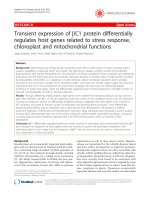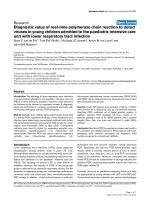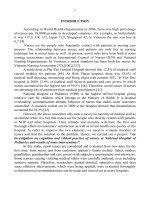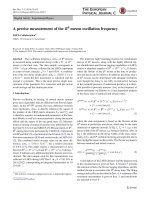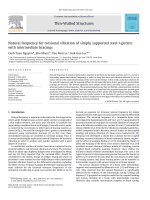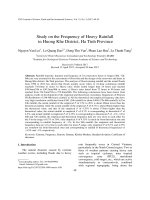DSpace at VNU: Distribution frequency of FCER2 genotypes related to corticosteroid response in asthma children treated at National Hospital of Pediatrics 1. Ly Huong. QT
Bạn đang xem bản rút gọn của tài liệu. Xem và tải ngay bản đầy đủ của tài liệu tại đây (1.03 MB, 6 trang )
JOURNAL OF FRENCH-VIETNAMESE ASSOCIATION OF PULMONOLOGY
2016 JFVP. www.afvp.info. Print: ISSN 2264-7899. Online: ISSN 2264-0754
J Fran Viet Pneu 2016; 20(7): 1-78
CrossRef: :10.12699/jfvp.7.20.2016.58
ORIGINAL ARTICLE
H. Duong Thi Ly1, N. Pham Thi Hong1, T. Vu Thi1, H. Nguyen Thi Bich2, H. Le Thi Minh2, S. Duong-Quy3
3:
Lam Dong Medical College. Dalat; Paris Descartes University-France; Penn Sate University of Medicine-USA
SUMMARY
Introduction. Recent studies showed that FCER2 is an important gene related to regulate IgE production which is a mediator associated with asthma.
Method. In this study, PCR-Sequencing was used to analyze FCER2 polymorphism in 130 patients at National Hospital of
Paediatrics.
Results. The results of the present study showed that 17 SNPs in FCER2 were identified and had strong linkage. These 17
SNPs recombinated into 5 haplotypes, in which h1 and h2 had the most frequency; Rs28364072 polymorphism in FCER2 is
well known to be associated with exacerbation of asthma, subjects who were homozygous for the CC mutant alleles was
significantly associated with elevated IgE level, severe exacerbations, the risk of asthma-related hospitalization, and also
associated with increased daily corticosteroid dose.
Conclusion. In this study, frequency of alleles C in rs28364072 in asthmatic children was similar with that in Kinh
HoChiMinh city in the project genome 3, but significantly different from patient group without asthma (p<0,05).
KEYWORDS: rs28364072, FCER2, pediatric asthma
RÉSUMÉ
Introduction. Des études récentes ont montré que le FCER2 est un gène important lié à la régularisation de la production
d'IgE, qui est un médiateur associé à l'asthme.
Méthode. Dans cette étude, la PCR-séquençage a été utilisé pour analyser FCER2 polymorphisme chez 130 patients à l'
Hôpital National de la Pédiatrie.
Résultats. Les résultats de cette étude ont montré que 17 SNP dans FCER2 ont été identifiés et avaient liaison forte. Ces 17
SNPs recombinés en 5 haplotypes, où h1 et h2 avaient le plus de fréquence; Rs 28364072 polymorphisme dans FCER2 est
bien connue pour être associée à une exacerbation de l'asthme, les sujets qui étaient homozygotes pour les allèles mutants
CC était significativement associée à taux élevé d'IgE, les exacerbations sévères, le risque de l'hôpitalisation liée à l'asthme,
et également associée à une augmentation la dose quotidienne de corticostéroïdes.
Conclusion. Dans cette étude, la fréquence des allèles C rs28364072 chez les enfants asthmatiques était semblable à celle
dans la ville Kinh HoChiMinh dans le génome du projet 3, mais significativement différent du groupe des patients sans
asthme (p <0,05).
MOTS CLÉS: rs28364072, FCER2, enfance asthmatique
Corresponding author: Dr. DUONG THI LY Huong. Faculty of Medicine and Pharmacy. Vietnam National University Hanoi. E-mail:
58
VOLUME 7 - NUMERO 20
J Fran Viet Pneu 2016;20(7):58-63
H. DUONG THI LY
FREQUENCY OF FCER2 GENOTYPE DISTRIBUTION IN ASTHMA
INTRODUCTION
Asthma is a common chronic inflammatory disease
of respiratory tract in both adults and children. So
far there are about 300 million of people with asthma
in the world. It is estimated that in 2025, more than
100 million of other people will suffer from asthma
worldwide [1]. To maintain, control and prevent
asthma well, the selected drugs include inhaled corticosteroids (ICS), β2 enhanced drugs, longacting beta-agonist (LABA), leucotrien-antagonist
drugs, etc ... [2,4]. In these drugs, ICS are most commonly used for the asthma control and prevention.
However, every race, every individual has different
response to ICS. There are many factors affecting the
drug response at the level of individuals, in which
genetic differences affecting corticoid response have
been studied by many authors.
FCER2 is a protein-coding gene, which plays an important role in the regulation of IgE production, an
important mediator of allergic asthma located on
chromosome 19. The Single Nucleotide Polymorphism (SNP) at rs28364072 of FCER2 gene supposedly related to the severity of asthma [3,5], the risk of
asthma-related hospital visits, and length of hospitalization [3,5,6]. Researches show that the mutations
of replacing T by C in rs28364072 of FCER2 gene are
associated with the increased IgE levels and increased risk of exacerbations in asthma patients using ICS [3,5-7].
The project of sequencing the human genome "1000
genome" in Phase 3 was conducted in a total of 2504
people in 26 countries worldwide, including Kinh
people living in Ho Chi Minh city. Results showed
that the rate of minor Alleles frequency (MAF) (C) of
rs28364072 in Kinh people living in Ho Chi Minh
City is 0.364 [8]. Does this ratio differ from that of
patients with asthma? And does this affect treatment
effectiveness? This study aims to partly answer the
questions above.
SUBJECTS AND METHODS
Subjects
Patients checked-up and treated at the National Hospital of Paediatrics from July to August of 2015. This
study was approved by the Ethical Board of National Hospital of Paediatrics (Hanoi, Vietnam).
FCER2 genotype analysis was conducted at the Department of Basic Sciences in Medicine and Pharmacy, School of Medicine and Pharmacy, Vietnam National University-Hanoi with 5-step process as follows: arm vein blood sampling; separation of DNA
from peripheral blood; designing the specific primers for gene cloning; amplification by PCR of genomic regions of interest; determining genotype by
two-way sequencing method at First Base Company
(Malaysia).
Statistical analysis
Determining the frequencies of genotype and alleles
of determined gene segments, comparing those between the asthma group and the control group to
find out the difference in frequency of genotype, and
then comparing the results with the theoretical frequency of balanced populations, followed HardyWeinberg's rule with chi-square test.
Linkage disequibrium (LD) and haplotypes analysis:
using the software of SNPAnalyzer 2. Expectationmaximization (EM algorithm) and ExpectationPartition-Ligation-maximization (PL-EM) are used to
evaluate haplotypes frequencies; Gabriel’s method is
used to analyze the haplotypes structure [7].
RESULTS
Characteristics of study subjects
TABLE 1
Characteristics of study subjects
Characteristics of
study subjects
Asthma
group
(n=107)
Control
group
(n=32)
p
Average age, years
9.2 ± 2.5
5.4±1.2
<0.05
Female (Male), %
32.7 (67.3)
86.9 (13.1)
<0.05
Average height, cm
132.2± 13.3
105.5±8.9
<0.05
Average weight, kg
39.9± 10.2
17.3±5.4
<0.05
Diagnosis results, %
Asthma
(100%)
Inguinal
hernia
(30.6%)
Spermatic
cord cysts
(21.7%)
Hidden
testicles
(21.7%)
Hydrocele
testis
(13.0%)
Phimosis
(13.0%)
Methods
Designed case-control study, in which patients are
diagnosed asthma in the Department of Immunology, Allergology, and Rheumatology of National
Hospital of Pediatrics and the control group chosen
by the method of convenient sampling is children
without asthma, going to Hospital for the check-up
and surgery of the spermatic cord cyst, inguinal hernia, hidden testicle.
J Fran Viet Pneu 2016;20(7):58-63
VOLUME 7 - NUMERO 20
59
H. DUONG THI LY
FREQUENCY OF FCER2 GENOTYPE DISTRIBUTION IN ASTHMA
There are remarkable differences in age, gender,
height and weight of the two groups of patients with
and without asthma (Table 1). In the control group,
patients mainly involve in the surgery of the
reproductive system abnormalities such as inguinal
hernia, spermatic cord cysts, hidden testicles,
hydrocele testis, phimosis, which are common for
boys.
There are opposing distribution of allelic frequency
of major alleles and minor alleles between the asthma group and control group, in which the major alleles occupy high percentage in the asthma group
and low percentage in the control group and vice
versa. Ratio of major alleles in the asthma group is
similar to the frequency distribution of the whole
population of study subjects.
With the gender difference, the patients’ average
height and weight of 2 groups are different
(according to physiological characteristics). Due to
the convenient research sampling, in order to
compare the difference of rs28364072 in patients
with and without asthma, we acknowledge the
differences mentioned above.
There is a strong linkage among the SNPs in the
FCER2 gene analyzed, showing the similarities in the
proportion of major and minor alleles on all the
SNPs. The proportion of the major alleles in the asthma group is 0.7; and 0.4 in the control group. In the
SNPs detected, most alleles are distributed, following Hardy-Weinberg's law (p>0.05), except
rs4996972 and rs4996973 (p<0.05).
To analyze the haplotype and Linkage disequibrium
(LD) among the SNPs, we use the automatic analysis
software of SNPAnalyzer2. The results show that: in
the segment of FCER2 gene amplified, 5 haplotypes
appeared with the frequencies and the SNPs
sequence as shown in Figure 1.
The rs28364072 analysis on FCER2 gene
Sequencing FCER2 gene segment of 818bp long
containing rs28364072 showed that beyond
rs28364072, 16 different SNPs appeared with the
frequency of the alleles distribution as shown in
Table 2.
TABLE 2
The frequency of the alleles in the SNPs located on the FCER2 segment amplified in the
asthma group, the control group and in both groups
No
SNPs
The position in
chromosome
1
rs2277994
7690632
2
rs76013233
3
Alleles frequency
Alleles
P
value*
Asthma group
(n=107)
Control group
(n=32)
Both groups
(n=130)
T/C
0.724/0.276
0.457/0.543
0.677/0.323
>0.05
7690599
C/T
0.724/0.276
0.457/0.543
0.677/0.323
>0.05
rs77121754
7690596
T/C
0.724/0.276
0.457/0.543
0.677/0.323
>0.05
4
rs78283814
7690593
C/T
0.724/0.276
0.457/0.543
0.677/0.323
>0.05
5
rs75584211
7690592
A/G
0.724/0.276
0.457/0.543
0.677/0.323
>0.05
6
rs74927160
7690586
C/A
0.724/0.276
0.457/0.543
0.677/0.323
>0.05
7
rs2277995
7690583
A/G
0.724/0.276
0.457/0.543
0.677/0.323
>0.05
8
rs28364072
7690399
T/C
0.724/0.276
0.457/0.543
0.677/0.323
>0.05
9
rs4996972
7690327
G/A
0.762/0.238
0.457/0.543
0.707/0.293
<0.05
10
rs4996973
7690273
T/C
0.762/0.238
0.457/0.543
0.707/0.293
<0.05
11
rs2228138
7690170
C/T
0.721/0.279
0.457/0.543
0.672/0.328
>0.05
12
rs4996975
7690085
G/A
0.721/0.279
0.457/0.543
0.672/0.328
>0.05
13
rs4996976
7690082
T/C
0.725/0.275
0.444/0.556
0.683/0.317
>0.05
14
rs4996977
7690078
A/G
0.721/0.279
0.457/0.543
0.672/0.328
>0.05
15
rs4996978
7690056
T/G
0.725/0.275
0.457/0.543
0.676/0.324
>0.05
16
rs4996979
7690031
A/G
0.721/0.279
0.455/0.545
0.673/0.327
>0.05
17
rs4996980
7690026
C/T
0.716/0.284
0.435/0.565
0.664/0.336
>0.05
*: P-value for Hardy-Weinberg Equivalence of Alleles Distribution
60
VOLUME 7 - NUMERO 20
J Fran Viet Pneu 2016;20(7):58-63
H. DUONG THI LY
FREQUENCY OF FCER2 GENOTYPE DISTRIBUTION IN ASTHMA
FIGURE 1. Haplotype structure on FCER2 segment analyzed by SNPAnalyzer2 (Freq: Frequency).
FIGURE 2. The map of Linkage Disequibrium in 17 SNPs located on FCER2 segment. Each lozenge performed the
coefficient of determination (r2) between pairs of SNPs.
J Fran Viet Pneu 2016;20(7):58-63
VOLUME 7 - NUMERO 20
61
H. DUONG THI LY
FREQUENCY OF FCER2 GENOTYPE DISTRIBUTION IN ASTHMA
In 5 haplotypes formed, haplotypes h1 and h2 occupied the highest proportion; corresponding to 17
major alleles (h1) or 17 minor alleles (h2) of the corresponding SNPs. This demonstrates that the SNPs
have a very strong linkage and are often combined
together. This is also shown in Figure 2.
The results in Figure 2 show that the SNPs link closely together, with the coefficient of determination r2>
0.8. A lot of SNP couples have r2=1, showing that
they always go together.
Rs28364072 on FCER2 genes are thought to be related to the progression of asthma and increasing the
risk of exacerbations in patients with asthma using
ICS [3,5,6], so we focused on the analysis of SNP polymorphisms on study subject population. The results are shown in Table 3.
There is a statistically significant difference in the
alleles frequency between the asthma group and
control group (p = 0.004). The frequencies of Allen C
are 0.276 in the asthma group and 0.543 in the control group respectively.
Compared to the genome project in Phase 3 conducted on 2504 people in 26 countries worldwide, including Kinh people living in Ho Chi Minh City [8], the
results of the alleles frequency distribution of
rs28364072 are presented in Table 4.
Frequency distribution of FCER2 rs28364072 genotypes and alleles on study subject
populations
TABLE 3
Genotypes
Asthma group (n, %)
Control group (n, %)
TT
58 (54.2)
5 (21.7)
TC
39 (36.4)
11 (47.8)
CC
10 (9.4)
7 (30.4)
Total
107
23
T
155 (0.724)
21 (0.457)
C
59 (0.276)
25 (0.543)
Total
214
46
p
0.004
Alleles
TABLE 4
0.004
Comparing the alleles C frequency of rs28364072 located on FCER2 segment in different
research subject populations in the world
Research subject populations in the world
National Pediatric Hospital
Asthma
(B)
Control
(C)
Total
(B+C)
Kinh
People
in
HCMC
Sampling sizes
n=107
n=23
n=130
n=198
n=1008
n=978
n=1322
n=1006
n=694
Alleles C frequency
0.276
0.543
0.323
0.364
0.340
0.428
0.570
0.284
0.218
>0.05
<0.05
-
>0.05
>0.05
<0.05
<0.05
>0.05
>0.05
p compared to the
total study subjects
in the National
Hospital of
Pediatrics (B + C)
62
VOLUME 7 - NUMERO 20
East
Asia
South
Asia
Africa
Europe
America
J Fran Viet Pneu 2016;20(7):58-63
H. DUONG THI LY
FREQUENCY OF FCER2 GENOTYPE DISTRIBUTION IN ASTHMA
The results in Table 4 show that, if calculated on a
total of 130 study subjects (regardless the children
with or without asthma), our results are similar to
those of the research on 198 Kinh people in Ho Chi
Minh city in the genome project in Phase 3 (p> 0.05).
This rate is similar to the rate of occurrence in East
Asian people in general, slightly higher than the European and American people, but this difference is
not statistically significant. However, compared with
South Asian and African people, the frequency of
alleles C is lower with the statistically significant
difference (p<0.05). Interestingly, comparing between the asthma group and control group (without
asthma), the frequency of Alleles C in the control
group is higher.
DISCUSSION
The personalization in treatment is one of the trends
of modern medicine. So understanding the genetic
structure and distribution of allelic frequencies can
contribute significantly to the impact associated with
the clinical and treatment response.
Rs28364072 on FCER2 gene has been proved to affect
the severity of asthma [3,5], the number of
emergency hospital admissions for asthma, and
length of hospitalization [3,5,6]. Many studies have
shown the mutations of replacing T by C of
rs28364072 were associated with increased IgE levels
and increased risk of exacerbations in patients with
asthma using ICS [3,5,6]. This research has not
shown the relevance of genetic variants of
rs28364072 with clinical characteristics and treatment
response of asthma.
CONCLUSION
The analysis of FCER2 gene segment on 130 pediatric patients at National Pediatrics Hospital shows
that: identifying 17 SNPs with 5 haplotypes of
FCER2 gene segments analyzed. SNPs closely
interlink; the frequency of rs28364072 alleles C in
patients with asthma is lower than that of the control
group (with surgery of spermatic cord cyst, inguinal
hernia, hidden testicles) with statistically significant
difference.
However, it shows the differences in the frequency
distribution of alleles C between the asthma group
and control group, in which the frequency of allen C
in the control group is higher than that that of the
asthma group, with statistically significant
difference. In our study, the control group were
chosen by the convenient sampling method (the
children going to the hospital for the surgery of
cystic spermatic cord, inguinal hernia, hidden
testicles). The question if there is any correlation
between SNP rs28364072 polymorphism and the risk
of genital disease of male children or not should be
clarified in further studies.
Acknowledgement
The authors would like to thank the Vietnam National
University-Hanoi, project QG.14.59 for funding this
study.
J Fran Viet Pneu 2016;20(7):58-63
VOLUME 7 - NUMERO 20
63
